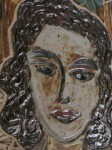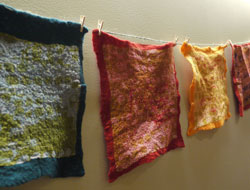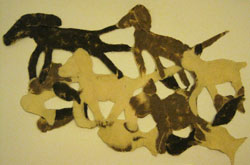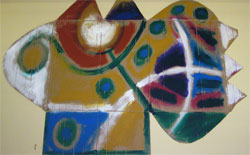Yinglei Zhang
From a young age, Yinglei Zhang was influenced by her family’s artistic friends and her father’s art collection. She began practicing Chinese calligraphy at age of 7. Beginning her studies in Chinese painting with Master Guo Ziyu in 1995, and with Master Li Xubai since 1996, She has also studied western Drawing and Oil Painting, Chinese Art History, and holds a MA from Saint Michael’s College with a focus in Comparative Art through independent study programs at both Shelburne Museum and in Paris in 2001. Her extensive and diverse studies have helped form her unique style. Yinglei’s knowledge of Chinese literature, poetry, and calligraphy provides a strong foundation that gives her artwork tremendous depth. The bamboo, plum blossom, and pine trees are symbols of integrity, strength, and beauty, often appearing in her work.
Yinglei blends her modernistic sense with more traditional structures of Chinese Painting to create her stylized source. While often sketching from nature, she infuses her own world perspective into each work of art. There is a clear sense of harmony and motion, an inner landscape open through the quiet details and graceful composition. Through the of use ink and limited color, working on Xuan paper with brush strokes that are dually subtle and bold, graceful yet full of strength, Yinglei draws the viewer to pause and take in her view.
Yinglei Zhang was born in China and came to United States in 1985 to pursue advanced study. After moving from coast to coast and living in more than ten places, she settled down in Middlebury, Vermont in 1997. She has made Middlebury her home ever since. She currently teaches Chinese painting privately and through Middlebury College, Williams College, The Park School, and many institutes in New England.
Klara Calitri

The symbiotic relationship between human beings and nature, Multi-Media Artist Klara Calitri’s new modernist abstract works clearly evoke the emotional tension necessary for integrating within our environment. Her expression of shadow, light and mood create
Born in Vienna, Austria, Calitri has been a long-time resident of Vermont. She received her B.A. at the University of VT, her M.A. at Cornell University and pursued doctoral studies at Columbia University. A visionary at 91, Calitri is continuing to master new forms of artistic expression, adding to her vast knowledge and experience of working with various art forms. Navigating the ever expanding course of her career has brought her to a place of defining freedom through abstraction. “My abstracts are sculptural, palpable works,” Calitri states. Through the Allegories series, she floods viewers with patterns and trails that guide into the past and future of her imagination and lead us deeply into our own; she is mapping the way for the rest of us.the opening through which we might pass into a new world of our own making.
Graziella Weber-Grassi

Graziella Weber–Grassi is a Swiss-born experimental artist currently residing in Whiting, VT. Her international art career has included multiple shows in New York and Geneva, several collaborative installations and an Artist Residency at Burlington City Arts for her interactive installation – NIMBY (Not in MY Backyard), as well as BCA sponsorship for Suddenly Visible – a “viral” outreach art exchange project to create humanizing global dialog during the height of the financial and housing crash. Graziella’s work explores subtexts ranging from how we collectively adapt and process crisis to compelling themes involving the deep undercurrents of memory. Her work sets the stage to explore and resolve our inner conflicts by approaching the lost innocence of childhood.
Compelling themes of childhood compete for attention in Graziella’s paintings. As adults, we look back nostalgically, yearning to recreate the sense of wonder and naiveté that is the province of youth. Yet darker, deeper undercurrents invade our experience, creating tensions between the hopes and dreams of a child and the reality of imperfections held in sacred family secrets shielded by almost impenetrable facades. In a playful way Graziella juxtaposes memories from her Swiss childhood with quintessential Americana images evocative of the pop culture of the 1940s. Her collage-like canvases set the stage for people to explore and resolve their own inner conflicts while searching for the lost innocence of childhood. Visit Graziella’s website.
M P Landis
 M P Landis’s current work is a palimpsest of the processes, materials and emotions of his existence. He has collaborated with musician Tom Abbs, visual artists Paul Bowen and Bert Yarborough, writers Nick Flynn and many others. Landis has taught at the summer workshop program at the Fine Arts Work Center in Provincetown, MA. He is a Creative and A&R Consultant for Northern-Spy Records. His work is represented in many private and public collections, including the New York Public Library, the Peabody Essex Museum, the Bowdoin College Museum of Art, the DeCordova Museum, the Naples Museum of Art, and the Provincetown Art Association and Museum. Before moving to Brooklyn in 1996, he lived year-round in Provincetown, MA, and spent his childhood traveling around the world with his Mennonite missionary parents.
M P Landis’s current work is a palimpsest of the processes, materials and emotions of his existence. He has collaborated with musician Tom Abbs, visual artists Paul Bowen and Bert Yarborough, writers Nick Flynn and many others. Landis has taught at the summer workshop program at the Fine Arts Work Center in Provincetown, MA. He is a Creative and A&R Consultant for Northern-Spy Records. His work is represented in many private and public collections, including the New York Public Library, the Peabody Essex Museum, the Bowdoin College Museum of Art, the DeCordova Museum, the Naples Museum of Art, and the Provincetown Art Association and Museum. Before moving to Brooklyn in 1996, he lived year-round in Provincetown, MA, and spent his childhood traveling around the world with his Mennonite missionary parents.
Rachel Baird

Born in San Francisco, Modern Expressionist Rachel Baird began her art career at age seven when a self-portrait was exhibited at the De Young Museum. Her first solo exhibition took place at age fifteen. She has been exhibiting ever since.
Rachel attended the S. F. Art Institute and the Academy of Art University – San Francisco as well as studying with George Longfish, tenured art professor at U.C. Davis, California. She holds a degree in Fine Arts.
Her search for elemental wildness sent her traveling, eventually spending several years in Colorado before moving to Vermont in 2003. Rachel says her main focus when painting with oils is capturing the movement behind what the eye can see: The force of nature in all things. She is currently exploring Kinetic Visual Art through use of a wide variety of media and conceptual installations. Visit Rachel’s website.
Deborah Allen
 I grew up, as many in New England did, learning how to knit and sew and stitch, more for the benefits of self-sufficiency than as art. My love of creating with fiber was seated and has gained traction as I have explored felting. My early work reflected my gardens—flowers and pods and leaves adorning felt purses and pillows. My current work with felt feels less functional and more imaginary. Whenever I am outside, I find another interesting rock or shell or tree that I want to mimic in wool; or that provides a spark for my imagination. I try to capture some of that sense of awe and magic and surprise that nature provides. I am not trained as an artist, and have therefore found most of my successes born of mistakes and errors along the way, which has been some of the fun. I have been featured in Belle Armoire and Haute Handbags.
I grew up, as many in New England did, learning how to knit and sew and stitch, more for the benefits of self-sufficiency than as art. My love of creating with fiber was seated and has gained traction as I have explored felting. My early work reflected my gardens—flowers and pods and leaves adorning felt purses and pillows. My current work with felt feels less functional and more imaginary. Whenever I am outside, I find another interesting rock or shell or tree that I want to mimic in wool; or that provides a spark for my imagination. I try to capture some of that sense of awe and magic and surprise that nature provides. I am not trained as an artist, and have therefore found most of my successes born of mistakes and errors along the way, which has been some of the fun. I have been featured in Belle Armoire and Haute Handbags.
I have long wanted to felt some prayer flags, never dreaming that a local visit by the Dalia Lama would be the final impetus to get such a project underway. Friends of friends collected prayers for me, and by the time the prayer-inscribed silk hankies got back to me, I found myself humbled by the trust that complete strangers placed in me, to handle their prayers with respect and dignity. I chose the colors of autumn—reds and oranges and rusts, and the deep blue of late-summer Lake Champlain—to distinguish the Vermont prayers; and fastened them to twine with little clothes pins, to capture that special sense of simple practicality that Vermont represents in an increasingly complicated world.
Christa Fischer
 I have had lifelong connection to sheep and wool. My mother knitted constantly, I married a sheep farmer and I just recently discovered that my early ancestors lived in the mountains ofNorthwestern Greecewhere shepherding is a way of life. The acorn has indeed not fallen far from the tree in my case.
I have had lifelong connection to sheep and wool. My mother knitted constantly, I married a sheep farmer and I just recently discovered that my early ancestors lived in the mountains ofNorthwestern Greecewhere shepherding is a way of life. The acorn has indeed not fallen far from the tree in my case.
I became interested in needle felting at the Rhinebeck Sheep and Wool Festival and fell headlong into the fabulous world of felt from that point on, taking workshops, studying, experimenting and searching out felt exhibits at home and abroad. Among the teachers I have studied with are Brigitte Krag Hansen. Beth Beede, Jorie Johnson, Inge Bauer and Polly Stirling.
A highlight for me was a trip to the Festival of Folk Arts inBudapest,Hungaryin 2004 where felt was featured and also shown in several museums in the surrounding area. I am currently a member of the International Felt makers Association and a felting instructor atFeatherstoneCenterfor the Arts on Martha’s Vineyard.
Frank Asch
 For quite some time now I’ve reached that point in my artistic evolution where I create out of necessity: the necessity of feeling alive, the necessity of feeding my soul, the necessity of addressing the boredom that otherwise weighs my spirit down. These cardboard pieces started with an alteration to the basic unfolded cardboard box shape. I simply sliced them up with a mat knife until I found something that pleased me. Then I applied the paint out of the tube smearing colors together with paper towels. I sometimes think I paint like dogs eat: hardly stopping to savor the flavor. Feeling an urge to get shapes and colors down, I swallow quickly without chewing over my food. Decisions are made along the way but I like to make them before I have a chance to think about them too much.
For quite some time now I’ve reached that point in my artistic evolution where I create out of necessity: the necessity of feeling alive, the necessity of feeding my soul, the necessity of addressing the boredom that otherwise weighs my spirit down. These cardboard pieces started with an alteration to the basic unfolded cardboard box shape. I simply sliced them up with a mat knife until I found something that pleased me. Then I applied the paint out of the tube smearing colors together with paper towels. I sometimes think I paint like dogs eat: hardly stopping to savor the flavor. Feeling an urge to get shapes and colors down, I swallow quickly without chewing over my food. Decisions are made along the way but I like to make them before I have a chance to think about them too much.
My process for creating ten minute plays is, I believe, a similar approach. I start with a premise, a situation, a setting, or some random characters. Then I let the characters start talking and see if it goes anywhere. I kind of feel like a kid pouring water onto the beach and running ahead of the stream with my plastic shovel to direct it’s flow, turning it, pooling it, stopping it now and then as it makes it way to the ocean.
Karla Van Vliet
 Karla Van Vliet is a painter, poet, and student of the dream. Van Vliet has long been fascinated with creating meaning and opening places of feeling by generating marks on the page, be it letter or character, dendritic form or simple line and shape. Her work originates from the practice of listening inwardly for what wants to arise and be expressed. From this Gnostic perspective, creation and content rise from the feeling, knowing self.
Karla Van Vliet is a painter, poet, and student of the dream. Van Vliet has long been fascinated with creating meaning and opening places of feeling by generating marks on the page, be it letter or character, dendritic form or simple line and shape. Her work originates from the practice of listening inwardly for what wants to arise and be expressed. From this Gnostic perspective, creation and content rise from the feeling, knowing self.
The discovered poems arise from pages of text; words are spotlighted to create a new meaning out of a prior existence, the discovered poem. As well Van Vliet has incorporated layering techniques and mixed-media methods to further develop the poems into artistic statements.
Zoe Riell
Zoe Riell is a Poultney native who has been published over 15 times in newspapers across Vermont through the Young Writers Project. Zoe also participated in the Brattleboro Literary Festival in 2012 and 2013 as the first prize winner of the Write Action Youth Poetry Contest. She was also awarded a regional silver medal in the Scholastic Art & Writing awards in the poetry category earlier this year. Zoe will be reading a selection from her award winning and new works.
Consuming Isle
Day two
I think I could come full circle,
glue the start to the ending ribbon
and make a bow of the affair.
But it’s raining now and I
have become habitually preoccupied
gathering runoff from the sea cliffs,
sleeping in my salvaged raincoat and
wondering why I ever thought swimming was fun.
I could have wandered here
and away again but I wandered here
and did not wander away when the tides crept in.
Day four
A piano washed ashore from the wreck yesterday;
ruined, of course, with a terrible wheeze.
It felt strange to leave it.
I contemplated dragging it to my driftwood lair,
but at sunrise it was gone, a memento on the horizon.
I watched the ocean swallow it
– then try to swallow me –
into the world.
I wished I wasn’t alone.
Day eight
The present consumes me.
Civilization hypothesized that I must think
of my future, because I am human.
But am I?
There is the sea that stretches like a wedding band
round this aisle, and there is me
amongst the kelp, the caves with their paintings,
and the fog that eludes my fingertips.
I dreamt of marriage, but now
am hand in hand with a footpath
to the cave that does not shelter from the rain.
Water has slithered into my eardrums.
Day fourteen
I have thought of the piano; should it return,
I’d harvest the keys and line them
up, a whole-step at a time
to make steps to the lighthouse,
away from the salt that has brittled my hair
and eroded the tally marks on the west cliff face.
I have circled, been lost, found
lost, but now I see the way
to the moon; I am falling, friend,
down to the seashells on the seashore.
But I never was, and, therefore, am now
at the end of the line
stemming from my sternum that merges
with the disappearing skyline.
Day twenty
I was, am,
afloat in only the shallowest pools .
I entered this body in a wave of liquid; I suspect I shall
leave it in a similar fashion.
Even now, the shoreline grows fragmented;
pieces have fallen out of my field of vision.
I heard a child cry out last night –
I crept to the sea strand, but behold:
The earth echoes my own voice.
Day twenty-two
I now count down to my own sunset.
An apt maneuver, as I have spent twenty-two nights
draped across cooling boulders, waiting for comets, wishing
to fill my emptying stomach.
I am losing this world and everything outside and in
between, for lack of a willing grip upon the sand.
Day twenty-three
I am lost with no one
to tell—who, then, shall piece together the piano?
It dashed against the rocks last night,
a howling scream, worming through the mists.
I fear I will be next, when the atmosphere readies once more.
Day twenty-six
I cannot sleep; that is
not unusual, I think, for someone
like me?
I have ceased to speak, even to myself.
Day twenty-eight
I can feel the weight
leaving my breastbone. I am open again
to the salty earth.
Day twenty-nine
I was never once upon this island.
I feel that now.
Day thirty
I am the offspring of the waves
Day thirty-one
I am returning.
© Zoe Riell, 2014

